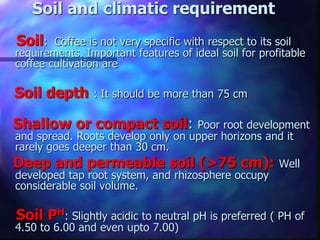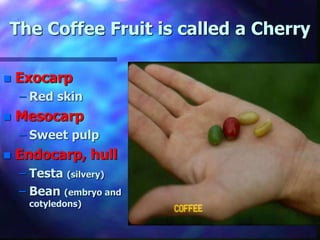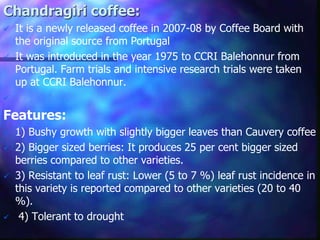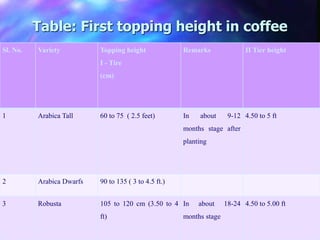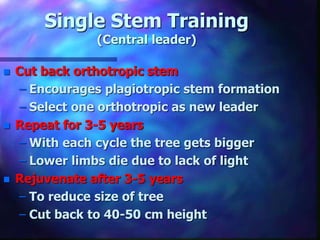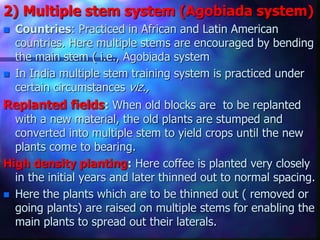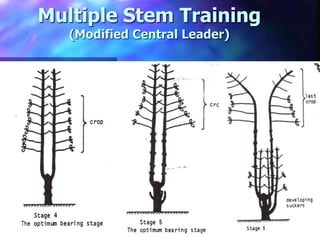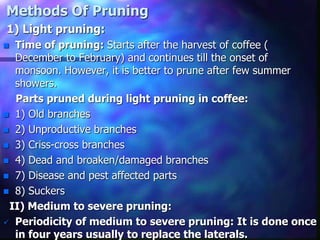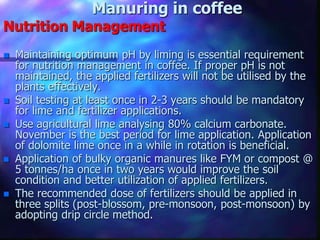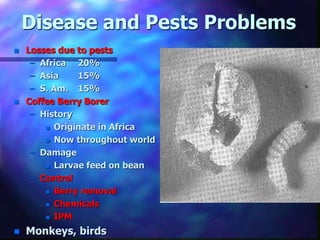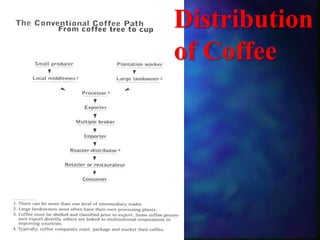A presentation on Coffee
- 1. Coffee Family - Rubiaceae Genus - Coffea Species - arabica and canephora Presentation By: Rajat Sharma
- 2. Brief History of Coffee Origin Coffee’s origin can be traced to the 12th century in Ethiopia, where it is believed to have been first harvested. “Traders brought coffee to the Middle East, from where it began to spread outward in the 15th century, penetrating every corner of Europe over the next two hundred years”. Coffee became a very important means of European trade as it spread to the Dutch’s, French’s, and British’s colonies during the 18th and 19th century. At this time, people from Africa and natives of the colonies were enslaved to work in the coffee plantations. “During the period of decolonization, coffee was put forward as a miracle crop that would allow developing countries to achieve economic growth.”
- 3. Distribution of Cultivated Coffee Amsterdam Paris canephora arabica Yemen 1710 1725 1690 1700 Java Martinique 1900
- 4. Soil and climatic requirement Soil: Coffee is not very specific with respect to its soil requirements. Important features of ideal soil for profitable coffee cultivation are Soil depth : It should be more than 75 cm Shallow or compact soil: Poor root development and spread. Roots develop only on upper horizons and it rarely goes deeper than 30 cm. Deep and permeable soil (>75 cm): Well developed tap root system, and rhizosphere occupy considerable soil volume. Soil PH: Slightly acidic to neutral pH is preferred ( PH of 4.50 to 6.00 and even upto 7.00)
- 5. Table: Soil and climatic requirement for coffee SL. No. Climatic Factors Arabica coffee Robusta coffee 1 Soils Deep, friable, rich in organic matter, well-drained and slightly acidic PH ( PH of 6 to 6.50) Same as in arabica 2 Extent of Slope Gentle to moderate slope is ideal Gentle slope to fairly level fields to be preferred 3 Aspect North/East/North-Eastern aspects are ideal North/East/North-Eastern aspects are ideal 4 Elevation for better growth and yield (m) 1000 to 1500m 500 to 1000m 5 Temperature 15 C to 25 C, cool equable 20C to 30 C, hot, humid 6 Relative humidity 70 to80 % 80 ot 90 % 7 Annual rainfall 1600 mm to 2500 mm 1000 to 2000 mm 8 Blossom showers ( 25 to 40 mm) March – April February – March 9 Backing showers (50-75 mm) April – May March – April
- 6. Table: Climatic factors adversely affecting production of coffee Sl. No. Climatic Factors Arabica coffee Robusta coffee 1 Absence of blossom showers during March- April March 2 Absence of backing showers during Delayed beyond one month after blossom showers – Poor crop set Delayed beyond 20 to 25 days after blossom rain - Poor crop set 3 Hail storms Injures floral and vegetative parts Same damage as in arabica coffee 4 Rain on the day of blossom Partial or complete failure of the crop Partial crop failure 5 Western/Southern Exposure ( with poor soil moisture) Partial or complete failure Partial crop failure 6 Wind exposure Sensitive Sensitive
- 7. The Seed of the Fruit is the Economic Part A Drupe like a Peach Both begin bearing in 3-4 years Time to mature fruit – Arabica, 7-8 months – Robusta, 11-12 months Productive for 20-30 years Both need pruning for best production
- 8. The Coffee Fruit is called a Cherry Exocarp – Red skin Mesocarp – Sweet pulp Endocarp, hull – Testa (silvery) – Bean (embryo and cotyledons)
- 9. The Coffee Fruit is called a Cherry Exocarp – Red skin Mesocarp – Sweet pulp Endocarp, hull – Testa (silvery) – Bean (embryo and cotyledons) – Parchment coffee is the bean, testa, endocarp
- 10. Coffee Production and Yield 0 0.1 0.2 0.3 0.4 0.5 0.6 0.7 % Production MT/ha 0.2 0.36 0.19 0.56 0.42 0.65 0.19 0.7 Africa Africa C.Amer C.America S.America Asia Asia
- 11. World Coffee Production Brazil – 21.1%, arabica – Only country with frost possibility in coffee zone Colombia – 13.9%, arabica Indonesia – 7.3%, robusta Other important producing countries – Vietnam, Mexico, Ethiopia, India, Guatemala, Ivory Coast, Uganda
- 12. Total area under coffee :11.6 million ha.
- 13. r- Coffea canephora m- Coffea canephora & Coffea arabica a- Coffea spp. Coffee growing region of the World Source: Wikipe
- 14. Gresser, Charis and Sophia Tickell. “Mugged: Poverty in Your Cup.” Oxfam International 2002:7 World Coffee Production
- 15. Total area under cultivation of Coffee in India 333,000 ha Total production of coffee 276,350 MT Main coffee type #1 Arabica #2 Robusta Largest Coffee producing state: Karnataka 183,100 ha (Area) 182,500 MT(Production) Coffee producing Region Area under coffee in India (2.60 per cent of world acrage (8th position in the world) Accounts for 3 per cent of world coffee production. area.
- 16. 1)Size of holdings in India: About 98 per cent of Indian coffee growers are of small holding (i.e., < 10 ha) accounting to 1.48 lakh growers. 2) Production and productivity of coffee in India: Productivity of Arabica coffee = 815 kg/ha Productivity of Robusta coffee = 1065 kg/ha Average productivity = 946 kg/ha
- 18. Major Consumers High proportion imported by developed countries – USA 23% – EEC 39%
- 19. Two Types of Coffee Arabica, C. arabica Tetraploid, self fertile Ethiopia highlands – >1600m – 15-24°C – 1300 mm Best quality Susceptible to rust Robusta, C. canephora Diploid, self incompatible Rain forest of Congo basin – <750m – 24-30°C – 1550 mm Less flavor, acidity Resistant to rust
- 20. Two Types of Coffee Arabica, C. arabica Medium size tree – 14-20’ tall Medium vigor Leaves – Smaller – Thinner Seedlings uniform Robusta, C. canephora Medium to large tree – Up to 32’ tall Vigorous Leaves – Larger – Thicker Seedlings variable
- 21. Arabica Coffee varieties developed at CCRI Balehonnur Variety Method of crop improvement Feature 1 Selection-1 S-288 Has high percentage of defective beans due to false poly embryony 2 Selection-2 Pedigree selection Seed distribution of this selection was withdrawn due to high bean abnormality 3 Selection-3 ( S- 795) Multiple crosses ( Released in 1945- 46) S-288 (S3l-1) x arabica = Selection –3 ( S-795) Has least bean abnormality when compared to S-288 ( Selection-1) Occupied large area under coffee since its release in 1945-46 High yield = 20 q/ha Good cup quality High proportion of A grade beans. 4 Selection-4 Pure line selection 5 Selection-5 Hybridization 6 Selection-6 Interspecific hybridization followed by back crossing S-274 ( A robusta type) X Kents ( Arabica) = F1 , F1 was back crossed with 7 Selection-7 (San Raman Hybrids) Multiple crosses (1953) San Raman is a dwarf mutant from – An arabica type. Introduced int in 1953. This mutant segregates into 70 per cent Dwarfs and 30 per cent Tall plants. Suitable for high density planting.
- 22. 7 Selection-7 (San Raman Hybrids) Multiple crosses (1953) San Raman is a dwarf mutant from – An arabica type. Introduced int in 1953. This mutant segregates into 70 per cent Dwarfs and 30 per cent Tall plants. Suitable for high density planting. 8 Selection – 8 (Hibrido- De timor) Pure line selection (1968 –69) Spontaneous hybrid of robusta and arabica, spotted from island and was given for cultivation from 1968 -69 9 Selection-9 Hybridization Selection-8 X Tafarikera = Drought hardy and widely adopted plants. Sln.9: Selection 9 is a derivative of a cross between an Ethiopian Arabica collection, ‘Tafarikela’, and ‘Hybrido-de-Timor’. Sln.9 has inherited all the superior cup quality traits of Tafarikela. This variety has won the Fine Cup Award for best Arabica at the ‘Flavour of India - Cupping Competition 2002’ organised by Coffee Board of India. 10 Selection – 10 Double crosses Caturra crosses other than HDT, Caturra is highly susceptible to rusts 11 Selection –11 Interspecific hybridization C. liberica X C. eugenioides obtained through amphiploidy. It resembles arabica and is resistant to leaf rust and moderately tolerant to drought. 12 Selection –12- (Cauvery/ Catimor) Exploitation of natural hybrids by involving hybridization Cross between Cauturra X HDT*
- 23. Cauvery Coffee (Selection –12)- Features: Cauvery hybrid is a F4 Cross between Caturra ( A semi dwarf variety of arabica ) X Hybrid de Timor ( A semi-dwarf hybrid) 1) Suitable for High Density planting: Cauvery is a compact bush with vigorous vegetative growth suitable high density planting. 2) Profuse branching: It is profuse branching, semi erect and droop when bearing. per primary=No. of primaries upto 1 m height. Nodes 16 to 20 (i.e., very close internodes) 3) Precocious : Early flowering and = Early bearing 4) Reaction to leaf rust : At the time of release it showed high resistance to leaf rust.
- 24. Chandragiri coffee: It is a newly released coffee in 2007-08 by Coffee Board with the original source from Portugal It was introduced in the year 1975 to CCRI Balehonnur from Portugal. Farm trials and intensive research trials were taken up at CCRI Balehonnur. Features: 1) Bushy growth with slightly bigger leaves than Cauvery coffee 2) Bigger sized berries: It produces 25 per cent bigger sized berries compared to other varieties. 3) Resistant to leaf rust: Lower (5 to 7 %) leaf rust incidence in this variety is reported compared to other varieties (20 to 40 %). 4) Tolerant to drought
- 25. Coffee Tree Growth Cycle Dry and/or cool season – Floral initiation – Reduced vegetative growth Wet season – Flowers open, fruit set and begin development – Active vegetative growth Dry and/or cool season – Fruit ripen – Flower buds initiate – Reduced vegetative growth
- 26. Coffee Tree Growth Habit Orthotropic stem – Erect growth Plagiotropic stems – Horizontal secondary stems growing off of orthotropic stems – These are the fruiting wood
- 27. Growing Conditions Grown under many conditions – Plantations – small farms – Under shade – In full sun – Monoculture – Mixed farming systems
- 28. Coffee Production Planting – Slightly acid (pH 5.2 to 6.3) well drained soil – Beginning of wet season – Vertical position or 30° angle Spacing - need light for fruit ripening – Arabica, 1350 trees/ha – Robusta, 900-1000 trees/ha Time to fruiting – Take 3-4 years to obtain mature plant – Fruit on year old wood
- 29. Planting and aftercare Site selection: The selected site should have following provisions; Water supply : As perennial source Soil rich in organic matter (humus) Gentle Slope : Slope towards N or NE or E direction Drainage : Provision should be there for adequate drainage Altitude: Minimum of 500 m asl (Arabica 1000 m to 1500m while robusta 500 m to 1000m asl) Wind break: Eastern wind during December- February causes injury to plants (cold injury). Hence, wind belts of silver oak or orange or tree coffee should be raised Partial shade: Clear natural vegetation for providing required partial shade to coffee growth. It can be done by selective felling /retention of desired species of wild shade trees in the natural forest vegetation.
- 30. SPACING AND PLANTING: SPACING Plane land = square system of planting sloppy lands =Contour planting Steep slopes = Terrace planting Sl. No Type of Coffee ( species) Variety Spacing 1 Arabica Talls 6’ x 6’ or 7’ x 6’ or 7’ x 7’ 2 Arabica Dwarfs (Cauvery / Sanramon) 5’ x 5’ 3 Robusta Talls (S-274 and old robustas) S-1 R and S-2 R 10’ x10’ or 12’ x 12’ 4 Robusta C x R ( S-3R) 8’ x 8’ Other robustas viz., Old robusta and S-274 10’ x10’ or 12’ x 12’
- 31. Opening up of pits Time: March-April (Immediately after the first few summer showers to give scope for weathering for about a month (at least 15 to 20 days)) Size of pit: Depending on soil depth /type 45 cm x 45 cm x 45 cm (LBD) - Always leave 15 –20 days for weathering. Planting material selection for planting: Seed propagation and Vegetative propagation A) Seed propagation in coffee Preparation of seeds Selection of berries: Only ripe berries are marked from marked coffee trees for seed collection and remove pulp and get beans. Discard floats and defective beans Seed treatment: Treat seeds with fungicide and dry seeds under shade.
- 32. B) Vegetative propagation: 1)Cuttings and 2) Grafting Propagation by cuttings: Selection of shoots: Select orthotropic (vertical shoots) suckers from elite trees. Age of shoot: Semihard wood and of about six months old. ( 3 to 6 months old shoots are better)
- 33. Shade and Coffee Production Both species are understorey trees – Well adapted to shade – Initially coffee was planted under shade – Small holders may use mixed farming Later unshaded plants were shown to produce higher yields
- 34. Shade and Coffee Production 0 1 2 3 4 5 6 7 8 Shaded Unshaded Fertilized No fertilizer Conclusion: High input system - better with fertilizer Low input system - not as essential
- 35. Coffee Production Training/Pruning objectives – Maximize # plagiotrophic stems (fruiting wood) – Shape trees Maximize use of space Ease of management – Maintain open tree to allow good light penetration – Minimize biennial bearing – Remove diseased and dead wood
- 36. Types of training Single stem training: Suitable under India conditions. Multiple stem: Practiced in American and Latin American countries. 1) Single stem system: Topping of growing main-stem Purpose of topping/capping: 1) To restrict vertical growth and facilitating lateral branching giving increased fruiting area. 2) Thickening of main stem: It also helps in diversion of food material to thicken the main stem and primary branches. As soon as the plant reaches a desirable height (first topping height) the growth of bush is restricted by topping/capping.
- 37. Raising of second tier: Depending on the fertility of the soil and spreading of the plant when plants attain about 4.50 to 5 ft height (135 to 150 cm) the second tier is raised.
- 38. Table: First topping height in coffee Sl. No. Variety Topping height I - Tire (cm) Remarks II Tier height 1 Arabica Tall 60 to 75 ( 2.5 feet) In about 9-12 months stage after planting 4.50 to 5 ft 2 Arabica Dwarfs 90 to 135 ( 3 to 4.5 ft.) 3 Robusta 105 to 120 cm (3.50 to 4 ft) In about 18-24 months stage 4.50 to 5.00 ft
- 39. Single Stem Training (Central leader) Cut back orthotropic stem – Encourages plagiotropic stem formation – Select one orthotropic as new leader Repeat for 3-5 years – With each cycle the tree gets bigger – Lower limbs die due to lack of light Rejuvenate after 3-5 years – To reduce size of tree – Cut back to 40-50 cm height
- 40. Single Stem Training (Central leader)
- 41. 2) Multiple stem system (Agobiada system) Countries: Practiced in African and Latin American countries. Here multiple stems are encouraged by bending the main stem ( i.e., Agobiada system In India multiple stem training system is practiced under certain circumstances viz., Replanted fields: When old blocks are to be replanted with a new material, the old plants are stumped and converted into multiple stem to yield crops until the new plants come to bearing. High density planting: Here coffee is planted very closely in the initial years and later thinned out to normal spacing. Here the plants which are to be thinned out ( removed or going plants) are raised on multiple stems for enabling the main plants to spread out their laterals.
- 42. Multiple Stem Training (Modified Central Leader) Leave 2-8 orthotropic stems Pruning – Cut out wood in center – Continues growing taller – Cropping area moves higher Rejuvenation every 4-6 years – Need to lower fruiting surface – Allow basal suckers to grow
- 43. Multiple Stem Training (Modified Central Leader)
- 44. Multiple Stem Training (Modified Central Leader)
- 45. Multiple Stem Training (Modified Central Leader)
- 46. PRUNING IN COFFEE Benefits of pruning in coffee: Yield regulation : Pruning reduces the risk of overbearing in any of the particular year. Pest and disease incidence : By pruning there will be better entry of sunlight and air in to the bushes there by minimizing the incidence of pests and diseases. Manageable shape : By proper pruning the tree is maintained in a manageable shape thereby improving the efficiency of field operations viz., spraying, swabbing, harvesting etc
- 47. Methods Of Pruning 1) Light pruning: Time of pruning: Starts after the harvest of coffee ( December to February) and continues till the onset of monsoon. However, it is better to prune after few summer showers. Parts pruned during light pruning in coffee: 1) Old branches 2) Unproductive branches 3) Criss-cross branches 4) Dead and broaken/damaged branches 7) Disease and pest affected parts 8) Suckers II) Medium to severe pruning: Periodicity of medium to severe pruning: It is done once in four years usually to replace the laterals.
- 49. Manuring in coffee Nutrition Management Maintaining optimum pH by liming is essential requirement for nutrition management in coffee. If proper pH is not maintained, the applied fertilizers will not be utilised by the plants effectively. Soil testing at least once in 2-3 years should be mandatory for lime and fertilizer applications. Use agricultural lime analysing 80% calcium carbonate. November is the best period for lime application. Application of dolomite lime once in a while in rotation is beneficial. Application of bulky organic manures like FYM or compost @ 5 tonnes/ha once in two years would improve the soil condition and better utilization of applied fertilizers. The recommended dose of fertilizers should be applied in three splits (post-blossom, pre-monsoon, post-monsoon) by adopting drip circle method.
- 51. Shade management Beneficial effects of shade in coffee – Quality improvement: Shade trees form natural canopy and it improves aromatic properties. – Improved foliar health: Shade helps in getting glassy elegant leaves and controls pre mature yellowing of leaves, defoliation and dieback. – Mulching effect: Leaves shed from the shade trees acts as soil mulch which in turn held in conserving the soil moisture and prevents soil erosion and improves soil organic matter status. – Temperature regulation: Insulation effect leading to buffering effect in soil temperature. – Improved organic matter status of soil : Decomposed leafy materials improves organic matter content of soil. There will be minimum loss of humus under shade thereby improving soil physical conditions. – Disease incidence : some of the diseases viz., Cercospora leaf spot and Colletotrichum etc are minimized under shaded situations – Yield regulations: Shaded situations prevents over bearing in any of the particular year and results in less variations / fluctuations in annual yields.
- 52. Coffee fruit, both ripe (red) and unripe (green).
- 53. A Typical “Sun Coffee” Plantation
- 55. Harvesting and yield Hastening fruit ripening in coffee: Purpose: Speedy and uniform ripening will give scope for quick and early harvest = reduced cost of harvesting in coffee. Harvesting the berries: In India there is only one cropping season. Arabica coffee harvested from November to January and Robusta coffee from December to February. The crop will be ready for the first harvest in about 3 - 4 years but economic yields are obtained from 5 - 12 years onwards upto 50 years. The berries are harvested when they turn red to deep crimson colour. Season of harvest is from October to February. Harvesting is done in stages as follows;
- 56. Harvest Most done by hand – Ripe berries only Pick every 8-10 days – In Brazil, allow cherries to dry on tree Machine harvest in Brazil
- 57. Fly picking: Small scale picking of ripe berries from October - November to February. Main picking: Well formed ripe berries are harvested in December. Stripping: All left over berries irrespective of ripening are harvested after main picking. Gleanings: Collection of fruits that have dropped down during harvesting.
- 58. Disease and Pests Problems Losses due to diseases – Africa 15% – Asia 10% – S. Am. 12% Coffee rust (Hemeleia vastatrix) – History First in Sri Lanka in 1880 Now throughout world – Control Robusta/hybrids resistant Less serious above 1700 m Cu fungicides Coffee Berry Disease (Colletotrichum) – Cause berry rot
- 59. Disease and Pests Problems Insert Fig 8.4, p 87 Losses due to pests – Africa 20% – Asia 15% – S. Am. 15% Coffee Berry Borer – History Originate in Africa Now throughout world – Damage Larvae feed on bean – Control Berry removal Chemicals IPM Monkeys, birds
- 60. Coffee Processing Bean Processing done on the Farm
- 61. Wet Method Start on Harvest Day – Separate trash and defective berries by flotation – Good berries are depulped same day Fermentation – Only to remove mucilaginous covering – Excessive heat destroys flavor
- 62. Wet Method Washed – Water under pressure Dried - spread out to dry – Sun – Artificial heat Best quality – Gives coffee that is cleaner, brighter, fruitier, better acidity
- 63. Dry Method (Natural Method) (Most traditional and least expensive) Drying (Indonesia, Ethiopia, Brazil, Yemen) – Initial drying done on trees – Spread on concrete, tile or matted surfac 2” thick and constantly raked 3-15 days until specific moisture Pergamino is dry and crumbly
- 64. Dry Method (Most traditional and least expensive) Remove pericarp – Mortar and pestle or machine Chaff removed via winnowing and picking Sorted by size, shape, density and color Packed in 60 kg bags for processing
- 65. Industrial Processing (Usually by importing company) Grading process – Redry and clean the parchment beans before using – Remove testa (hulling and polishing) – Sort on size and density Roasting (370°F to 540°F) – Removes moisture Light roast lose 3-5% moisture Dark roast lose 8-14% moisture – Time (up to 30 min) determines flavor
- 66. Industrial Processing (Usually by importing company) Caffeine Reduction – Add water to beans – Extract with Methylene chloride and ethyl acetate Residual solvent removed via low level steam drying – Caffeine can be recovered with water extraction of organic solvent
- 68. Any Questions?



